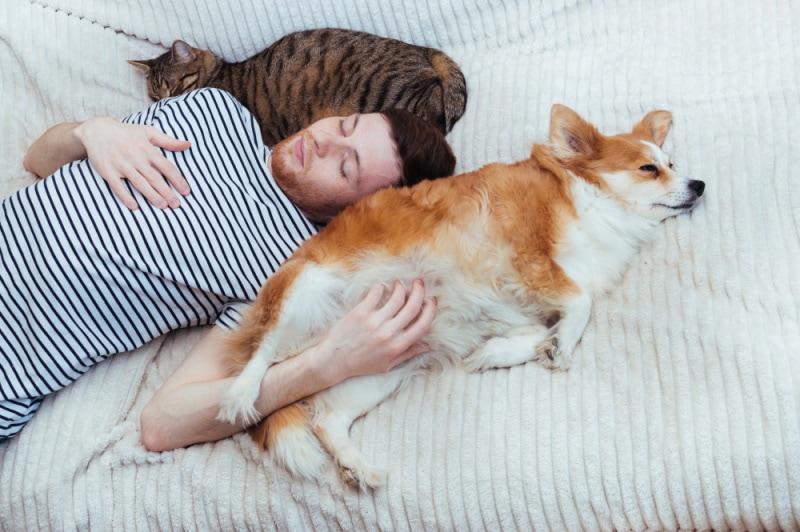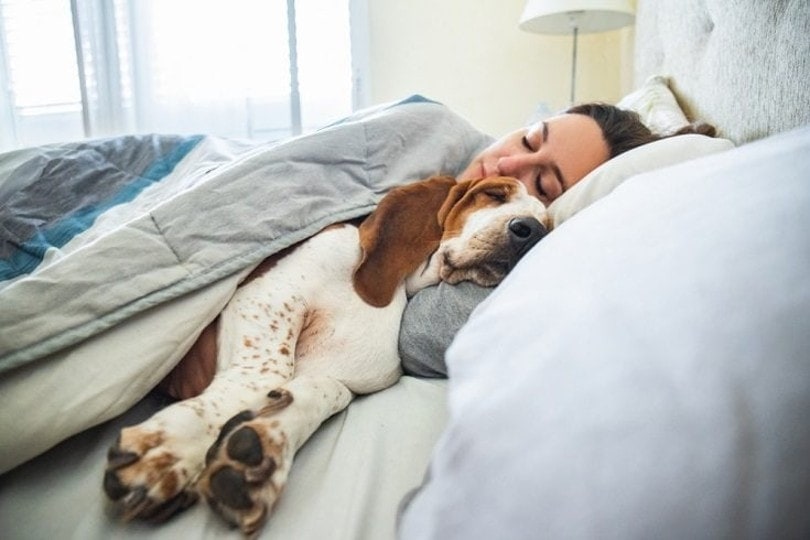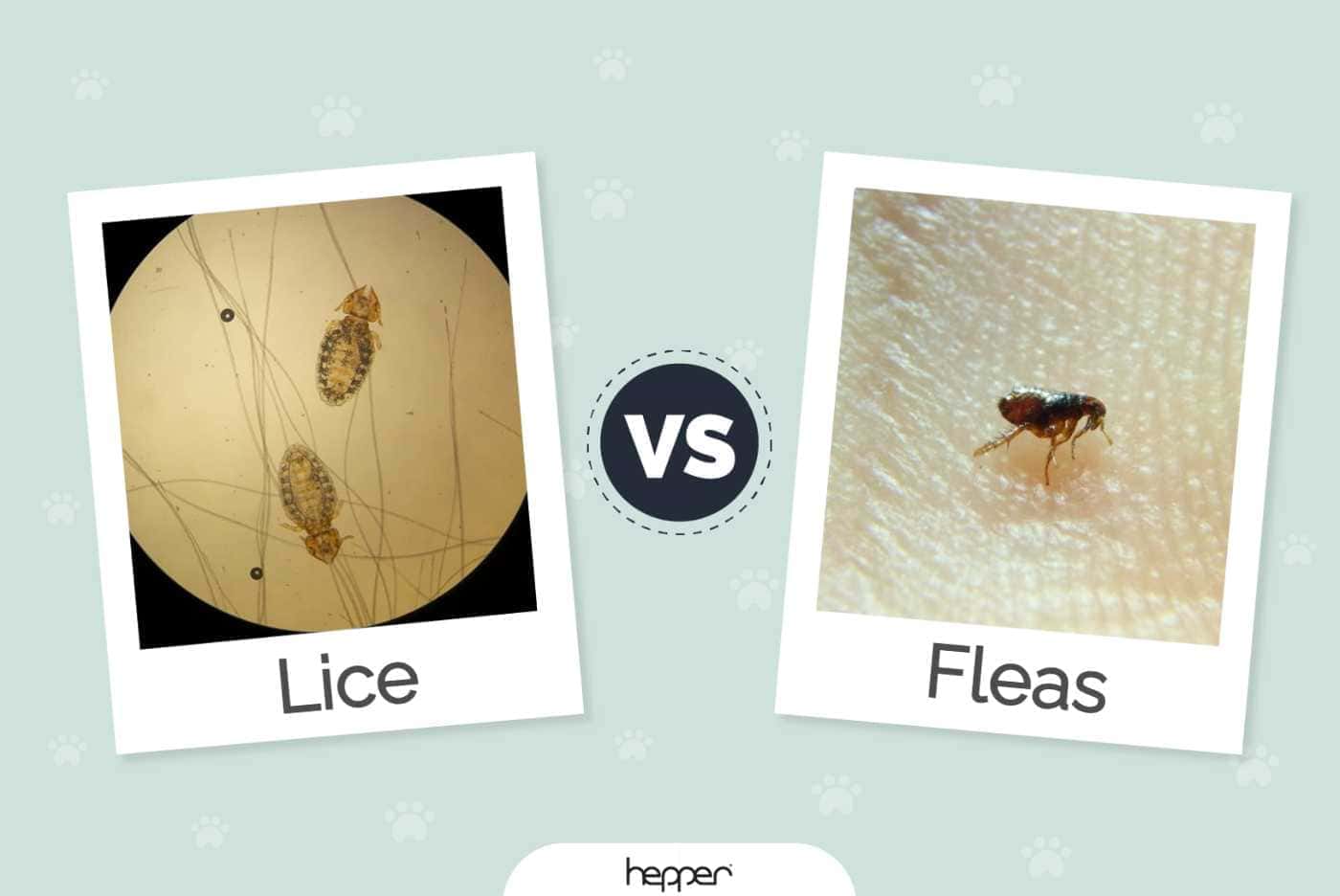How Many People Let Their Pets Sleep With Them? Statistics & FAQ

Updated on

The idea of sleeping with a pet is one that many find adorable and comforting. But how many people actually do it? Anecdotally, we can assume that a large number of us cuddle up with our animal friends at night, but is there any solid data to back this up? Unfortunately, there isn’t a ton of trustworthy information available on the subject. The numbers get especially patchy when it comes to less popular kinds of pets. Studies conducted on the topic often rely on a small sample size of respondents filling out questionnaires, which may not be particularly reliable.
The 2021–2022 National Pet Owners Survey by the American Pet Products Association,1 found that in the United States, 49% of pet cats and 43% of pet dogs sleep with their owners, on the owner’s bed Also, beyond cats and dogs, nobody is counting how many people sleep with their pet iguana. Read on to dive into the numbers, facts, and habits of people’s sleep habits with pets.
How Many People Sleep with a Cat or Dog?
The study found that the size of the dog influenced their ability to finagle their way into bed with their owners. Large dogs are the least likely to make it into their owner’s bed but still managed a solid 31%.
About a third of big dogs slept in their owner’s bed, whilst 41% of medium-sized dogs enjoyed the privilege, but a whopping 62% of small dogs snuck onto their owner’s mattresses.

Health Benefits of Sleeping with a Pet
Having a pet can add so much joy, love, and companionship to our lives. On top of all of that, they contribute to our well-being. Did you know that sleeping with a pet can also offer us physical health benefits? Do yourself a favor and catch forty winks with your bestie. Studies have shown that snoozing with a pet can provide numerous health advantages. When we sleep with a pet in our beds, the emotional connection and comfort of their presence can reduce stress levels, lower blood pressure, and improve overall cardiovascular health.
In addition, their warmth helps to bring about deeper levels of relaxation that result in better quality sleep. People who sleep with pets often fall asleep faster and experience fewer disturbances throughout the night than those who don’t share their beds with furry friends. It feels good to keep them close.
Another study in 2022 of 2,000 American pet owners sponsored by a mattress company found that 70% of people who slept with their pet believe they get a better night’s sleep, and between 40% and 50% claimed that with a pet in bed, it is easier to settle in for the night, they have better quality sleep and wake up more rested, and it makes them feel more secure at night.
The study also found that, on average, pets disturb their owner’s sleep two nights per week, and a quarter of owners said they are always woken in the middle of the night by their pets. You may or may not luck out. Ultimately it comes down to each individual and what they are comfortable with, and their relationship with their pet. And how wriggly they are.

Is it Safe to Sleep with a Cat or Dog in Your Bed?
Overall, yes. If you don’t suffer from allergies, then the health risk to you of allowing a cat or dog into your bed is fairly low. Any issues are most likely to come from your pet’s skin or fur from things they have picked up in their normal lives. Fleas and ticks are both vectors for infecting you with some not-very-nice diseases. Tapeworm, typhus, and Lyme disease can all be carried by cats or dogs and transmitted to humans through the bite or feces of ticks or fleas. None of those things are fun to experience. Ringworm is a fungal infection that people can catch from close contact with either dogs or cats.
Your favorite pets can also be carriers of salmonella; it is normally transmitted through contact with your pet’s feces, some of which may end up in your bed via contact with their fur or paws. However, as long as your pet is healthy the risk of passing on these unpleasant conditions to you is very low. But be mindful of hygiene. If you are, then the benefits of sleeping with your pet may far outweigh the risks and potential downsides.
Sleeping With Dogs
In general, dogs like to sleep with their owners, and when given the chance they will jump—right into your bed. For dogs, sleeping together is an important act that both demonstrates and grows the bond between them and you. Sleeping with you shows that the dog is willing to be close to you when they are vulnerable.
Dogs are naturally protective and by sleeping with your dog you are allowing it to fulfill this innate need to protect you. However, before deciding whether you allow your new puppy to sleep in your bed you should be sure that this is what you want to do for the rest of your dog’s life. Whilst you can re-train an adult dog not to sleep in your bed, or share your room, it will take work and persistence.

A well-socialized dog that knows its place is fine in the bed, but a dominant dog can be a problem, especially if they’re a large or powerful breed. A dominant dog may become overly protective of the bed and see it as their territory. Whilst they may not see you as a threat, they might see children or other pets differently. If your dog starts being aggressive, especially around the bed, you must act. Speak to your vet or an animal trainer and take the necessary steps to correct this behavior.
Sleeping With Cats
Cats can be very insistent—and demanding—when they want something. If a cat wants to get up and wants you to get up, they might start off gently, but pretty soon, they will be sitting on your face experimenting with cutting off the air supply to one or both of your nostrils, to see if you will respond. They probably want to get fed or to be stroked, or simply think you’ve had enough sleep. But this insistence can be positive. Cats like routine, and once a routine is established, they want to stick to it. So, if you are staying up too late past your, and your cat’s, bedtime, they will let you know. They will pester you to go to bed. And once your cat is in bed with you, they can be very loving and enjoy snuggling up with you.
To make sleeping with your cat successful, create a specific location in the bed for your cat and put a marker there, like a blanket for them to sleep on. Be aware that cats are very territorial, and once they start sleeping with you, your bed will become part of their territory. If later you try to take away this privilege from them, they are going to fight you for it; not in a direct way but by using their persistence. They will do their best to wear you down with their constant efforts to get you to change your mind and let them back into the bedroom.
Having a pet means finding ways to shower them with love and cuddles, even when you aren’t around. Whether you are at work all day or quickly running errands, the Hepper Nest Bed will keep your cat cozy, supported, and comfortable. Made from flexible molded foam and a self-warming sherpa fleece insert, your cat will be wrapped in a pleasant hug sure to keep them at ease. Having a modern Nest to to sleep in while you are away means more playtime and bonding when you are together. Learn more here.
- HAPPY COZY CATS - Your kitty will bask in luxurious sherpa-lined comfort while feeling warm, safe,...
- MODERN DESIGN - Contemporary styling with upholstered fabric construction; just like your human...
Tips for Sleeping with Your Pets
Follow these simple tips to set you and your pets up for successful nights sharing a bed.
- Big Bed: Your bed should be big enough for you and your pet to sleep comfortably, with space to turn over and not be in contact, should that be what you need.
- Hygiene: Keep your bed clean by frequently and regularly washing the sheets and bedding, as well as any blankets, cushions, or beds your pet uses. Consider wiping your pet’s paws and coat after they’ve been outside so as to keep dirt, feces, pesticides, and natural allergens out of your bedroom.
- Healthy Pets: Make sure your pet attends all their regular health checkups with the vet to keep them in tip-top condition and free from parasites and diseases.
- No Licking or Kissing Your Face: We know this one is painful for those who allow it, but contact between your pet’s mouth and your face is a potential vector for transmitting disease. Stop this bad habit and remove the risk.
- Walk Before Bed: Set the scene for sleep by taking your dog out for a quick walk, or putting your cat out in the garden for 5 minutes. This gives them a last chance to go to the bathroom and tells them mentally to prepare for sleep.
- Consistency: Pets thrive on habits and if you keep a regular routine with set sleeping and waking times, they are more likely to have consistently good nights—protecting you from their restlessness.
Final Thoughts
It is clear that many people enjoy the companionship of sharing a bed with their beloved pets. As many as 40–50% of cat and dog owners let their pets sleep with them. We can’t fault them, because it can be beneficial for both humans and animals, providing comfort and security for each. There is simply nothing cozier. And while it may not be ideal for everyone, there are ways to make it work if properly implemented.
It is important to take into consideration possible allergies, cleanliness, and sleep disruption when allowing pets in the bedroom or on the bed. Whatever you decide on, we hope you and your forever bestie rest well.
Featured Image Credit: Anastasiya Tsiasemnikava, Shutterstock













